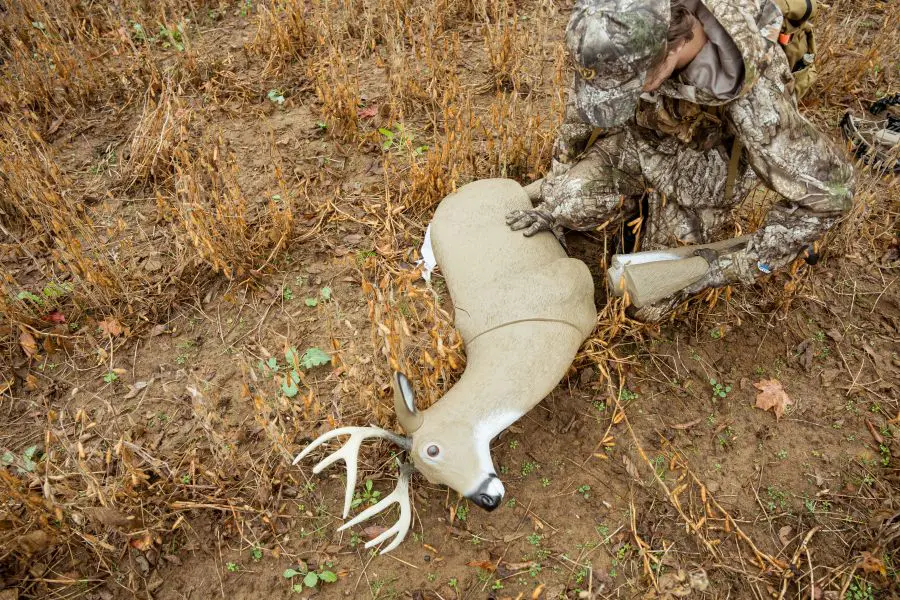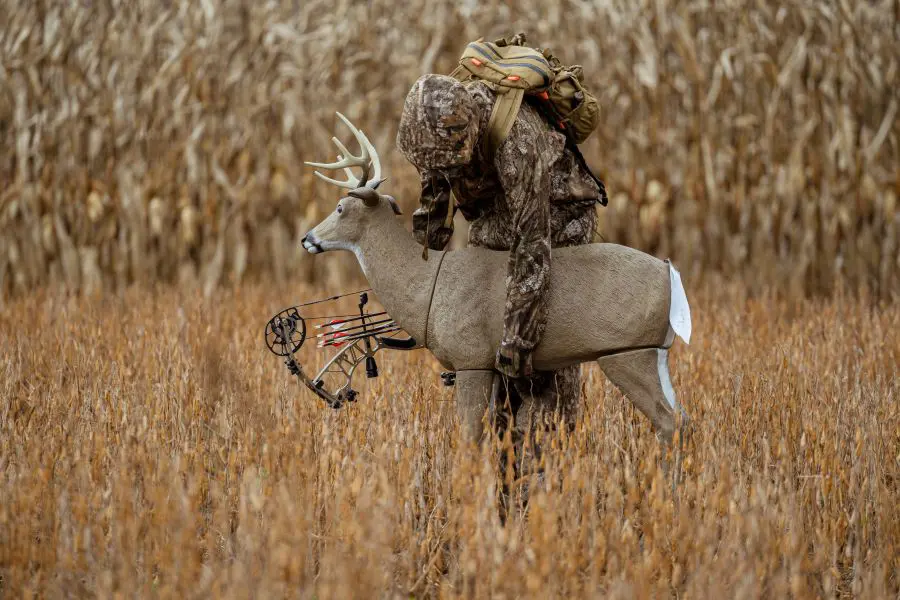When a mature buck steps into view and then turns to look at your decoy, his ears pin back, his neck swells, and the hair on his body stands up, making him seem like the king of the woods. Often, when a buck approaches a decoy, he licks his nose, and it almost seems as if steam comes from it as well. All his attention is on the decoy, and you send an arrow through his vitals, creating one of the most exciting hunting experiences you can have.
A wild animal’s behavior when a decoy is in place truly showcases nature’s artistry. The behavior observed is unmatched. When hunting deer with a decoy, success often depends on timing, stealth, and strategy. For both bowhunters and rifle hunters, one often-overlooked tactic that can improve your chances is using a realistic deer decoy. Whether you’re trying to lure a dominant buck into bow range during the rut or just stop a cruising deer long enough for a clean shot, a quality decoy can present opportunities you wouldn’t have otherwise.
The new Blocker Outdoors Ol’ Hank Deer Decoyis designed for mobile hunters who want to intensify the action or for hunters who like to pull deer from a distance while sitting in a warm ground blind on a cold November day during the rut. With lightweight construction, ultra-realistic detail, and an easy-to-assemble design, this decoy is built to spark curiosity and aggression in both bucks and does. If you’ve never used a deer decoy or haven’t had much success with one before, here’s a guide to help you do so effectively.

When To Use A Deer Decoy
Timing is everything when using a decoy. Deploy it at the wrong moment, and you might alert deer instead of attracting them. I’ve had many successful hunts with a decoy, but I’ve also experienced bad luck; bucks stomp, snort, blow, and do everything except come close enough to observe. Sometimes deer just take one look and bolt without hesitation. Many hunters share the same opinion about using a grunt call, scent, or decoy; they either love them or have had a bad experience, which makes them hate them. The truth is, if the timing isn’t right, it simply won’t come together. But when it is, hang on, because things can heat up fast.
Pre-Rut (Late October) is whenbucks ramp up their territory and testosterone levels. A buck decoy can trigger dominant behavior and attract deer from a distance. Most wildlife decoys are designed to lure animals, draw them close, and divert their attention away from the hunter. Pre-rut is one of the best times to start using a decoy.
Peak Rut (Early to Mid-November), bucks are actively seeking does. This means they are focused on breeding and the competition from other bucks. The Ol’ Hank Decoy has removable antlers to also serve as a doe decoy. When used with estrus scent, a doe decoy can attract love-struck bucks looking to breed.
Late season (post-rut), bucks are more cautious but still respond to visual cues, especially if food sources are nearby. When using a buck decoy late season, I employ a more subtle approach. I avoid grunting and rattling as I would during the pre-rut. Late-season decoys are mainly for visual attraction when a buck might be strolling by in the distance. Natural curiosity often draws bucks into close range to see what and who is in their territory.
So, here are three times to use decoys. Now, when to avoid using decoys is in the early season when deer are calm and not showing signs of aggression or breeding behavior. This is when a decoy can do more harm than good. It is also important to assess the current situation with bucks in your area and the caliber of bucks you have. If you don’t have many big, mature bucks, I would steer clear of using a decoy because younger bucks often see them as a threat. If you have a larger buck roaming around, then start using the decoy to create jealousy and make him charge in more aggressively.
How To Position Your Decoy
Proper decoy placement can make or break a hunt. Use these tips to ensure your decoy helps rather than hurts your setup.
- Wind Direction: Always set the decoy upwind of your position. Bucks often circle downwind to scent-check the decoy. This puts them between you and the decoy, ideally within shooting range.
- Distance: Set the decoy around 15–20 yards away from your stand or blind. This helps keep the deer’s attention focused on the decoy while giving you a clear shot opportunity.
- Facing Position: Face a buck decoy toward you. Dominant bucks typically approach head-on to assert dominance. With a doe decoy, face her away from your position, and bucks will often approach from behind.
- Body Language: The Blocker Outdoors Deer Decoy allows for subtle body positioning. Slightly angled body posture or an upright tail can mimic a live deer’s natural stance and increase realism.
Keeping Your Decoy Scent Free
Nothing ruins a decoy setup faster than human odor or unnatural scent.
- Storage: Store your decoy in a scent-proof bag or container. Keep it separate from your clothing and other gear that may carry human scent.
- Wash Before Use: Wipe down your decoy with scent-eliminating spray, especially after handling.
- Gloves & Rubber Boots: Always wear gloves and rubber boots when setting up your decoy to avoid transferring ground scent or human odor.
- Add Scent Correctly: Consider hanging scent near your decoy, instead of rubbing it on the decoy itself. This allows you to carry your decoy back home without getting scent all over yourself. In some cases, hunters prefer to hide their decoy overnight and use it again the next day. When there’s no scent on the decoy, deer are less likely to find it and get spooked while you’re away.
For peak effectiveness, pair your scent-free decoy with matching attractant scents like doe estrus or tarsal gland lure, depending on the decoy type and rut phase.

The new Blocker Outdoors Deer Decoy offers a game-changing advantage when used correctly. Its realistic appearance, portability, and smart design make it ideal for mobile and public land hunters who need fast, effective setups. It’s also great for drawing mature bucks out of thick cover or away from neighboring properties on your land, giving you a close-range shot without being detected.
Whether you’re rattling and calling during the rut or quietly waiting over a feeding area, adding a decoy can be the missing piece that pulls a mature buck into range. Keep your scent in check, play the wind, and place your decoy with intention, then be ready, because when it works, it can happen fast.

